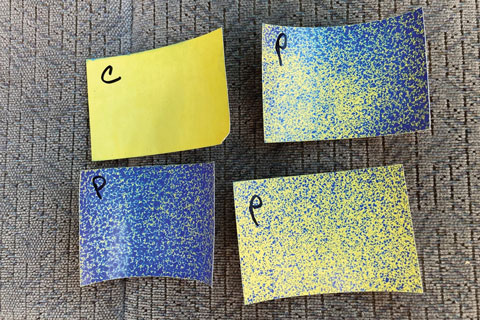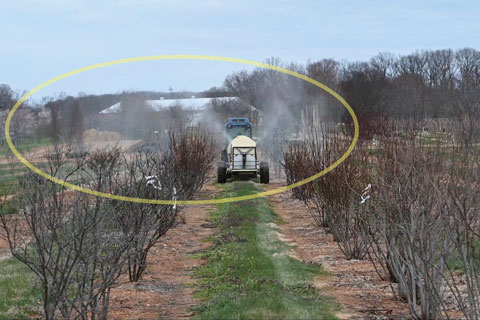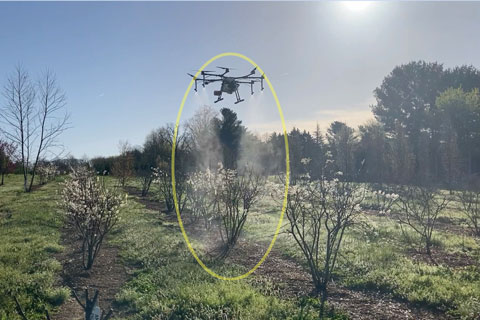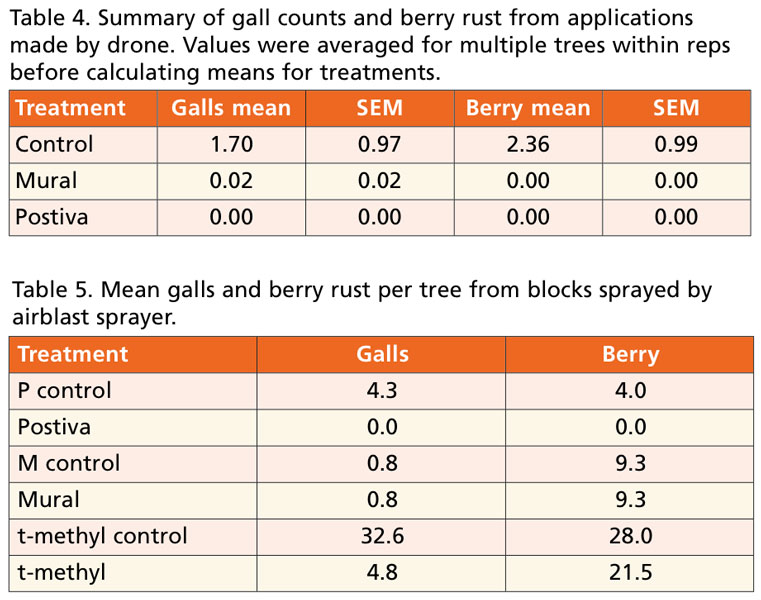2/1/2023
Disease Drones
David Clement, Stanton Gill, Sheena O’donnell, Kirk Floyd, Nancy Rechcigl & Alan Leslie

Unmanned aerial vehicles, better known as drones, are a new tool being used in nurseries for various tasks, such as applying granules, digital mapping for inventory or monitoring, and spray applications. Each of these tasks come with certain hurdles that must be overcome, whether it’s safety, cost or time.
Figure 1. Spray cards randomly placed in a Postiva-treated block. Since Postiva acts translaminally, all three locations were considered to have full coverage (cards labeled “P” were sprayed with Postiva, “C” were controls with no spray).
For this project, we chose to focus on spray applications. Traditional methods of spray applications involve extensive PPE, water use and labor time. Drones can be used instead of actual employees in the field to reduce the risk of exposure, the need for extensive and uncomfortable PPE, and water use for dilution. Additionally, we set out to look at the efficacy of these drone spray applications against traditional methods, such as an airblast sprayer.
Gymnosporangium clavipes, or Cedar-Quince Rust, is a major problem for nursery managers, especially on Amelanchier species. Amelanchier arborea is native to eastern North America, into Ontario and Lake St. John in, and to Texas and in the Midwest, including Minnesota.
In 2022, we teamed up with Andrew Janosek and Nick Graves at Ruppert Nursery in Laytonsville, Maryland, with severe Cedar-Quince Rust pressure on their Amelanchier arborea Autumn Brilliance causing extensive damage on branches and fruit. We compared drone applications of Postiva and Mural with the nursery’s airblast applications of Postiva, Mural, and the tank mix of Manzate and t-methyl.


Materials & methods
For the trial, we picked six widely separated plantings of Amelanchier arborea with 30 to 50 plants each. Drone applications were applied to three blocks of Amelanchier with four replications of Postiva and Mural to groupings of six treatment plants, including unsprayed control plants within the block.
Postiva is a combination broad-spectrum fungicide with the active ingredients Pydiflumetofen and Difenoconazole in FRAC groups 3 and 7. It’s a preventative fungicide labeled for leaf blights, powdery mildew and soilborne diseases such as Fusarium and rusts.
Figure 2. Airblast sprayer. Large drift cloud to the left and incomplete coverage to the right.
Figure 3. Drone sprayer. Small/negligible drift cloud and complete coverage of the target plant.
Mural is a combination of the two active ingredients Azoxystrobin and Benzovindiflupyr in FRAC groups 7 and 11. Mural can act in a translaminar and systemic way, and it’s labeled for control of a wide variety of ornamental diseases.
Airblast spray applications of Postiva, Mural and a Manzate + t-methyl tank mix were applied to three blocks of Amelanchier with controls. Drone application spray rates were adjusted by using spray indicator cards to ensure full coverage of the plants (Figure 1).
Ruppert also grows multiple rows of native Junipers (Juniperus virginiana) for native plant sales. Juniperus virginiana is the alternate host for several rust diseases that spread the disease in spring and early summer to susceptible broadleaf plants. Several Juniperus virginiana throughout the nursery were tagged in March and then monitored for the appearance of orange teliospore structures. The time at which these structures appeared determined the timing of the first fungicide treatments on the Amelanchier in April. We didn’t spray the Juniperus—just used it as an indicator to begin treatments.
The Amelanchiers used for the study varied from 3 ft. to 5 ft. in height and had been pruned back heavily over the previous two years due to rust and cicada damage. Each block of plants had separation between the control and treated areas. The airblast sprayer was supplied and operated by nursery personnel. All drone equipment was supplied and operated by Kdrone Services. Treatments were made at roughly two-week intervals from April through mid-May. Treatment information is listed in Tables 1 to 3.


Rust evaluations
To assess treatments, we visually measured the numbers of stem rust galls and fruit infections on the Amelanchier plants in each block. We evaluated the number of stem cankers and number of infected berry bunches on 6/14/22 and 7/21/22.
Results & discussion
Table 4 shows the mean and standard error for the number of galls per tree for each treatment. For this data set, we averaged the number of galls per tree for the multiple trees measured on each rep, then calculated the treatment means and standard errors from these values.
Table 5 shows the same values for the airblast study. There isn’t true replication for the airblast data, so the values are just the mean number of galls and infected berries per tree within each sprayed or unsprayed block. The number of infected berries and number of galls on the control plants were much higher than any of the treatments.

Conclusions
All rust fungicide treatments had a positive effect on disease severity and injury levels on Amelanchier as compared to airblast sprays. Treatment with any of the three fungicides showed improvement over controls. Out of the treatments, drone spray applications were visually better than the airblast applications. Overall, the drone treatments significantly managed the rust pressure in the nursery with much less active ingredient and water, as well as less operator time for each application. The drone treatments were much more targeted and had very little drift as measured visually and by spray indicator cards (Figures 2 and 3).
In this trial, we’ve demonstrated that the use of spray drones can make a significant positive contribution as a component of a nursery IPM disease management program. Our studies show that spray drones can be of key use in more efficient and targeted IPM management methods, which cuts down on water, chemical and labor costs. GT
David Clement is a Plant Pathologist and Stanton Gill is an Entomology and IPM Specialist at the University of Maryland Extension. Sheena O’Donnell is a Technician at the Central Maryland Research & Education Center. Kirk Floyd is owner of Kdrone Services. Nancy Rechcigl is with Syngenta’s Technical Services. Alan Leslie, with the University of Maryland Extension, conducted statistical help.